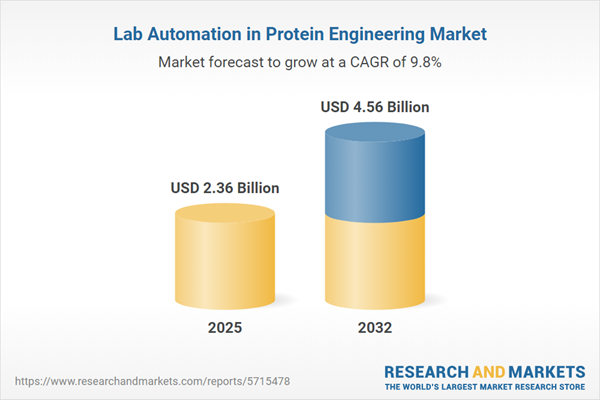Speak directly to the analyst to clarify any post sales queries you may have.
The Lab Automation in Protein Engineering Market is undergoing rapid transformation, enabling organizations to drive efficiency and innovation through seamless integration of advanced automation systems. By prioritizing precision, scalability, and data-driven workflows, senior leaders can unlock new levels of operational agility and competitive advantage.
Market Snapshot: Lab Automation in Protein Engineering
The global market for lab automation in protein engineering grew from USD 2.15 billion in 2024 to USD 2.36 billion in 2025, and is projected to reach USD 4.56 billion by 2032, reflecting a CAGR of 9.82%. This momentum is being shaped by the increasing demand across biotechnology, pharmaceutical, and academic sectors for flexible solutions that streamline experimental throughput and enhance data integrity.
Scope & Segmentation of the Lab Automation in Protein Engineering Market
This report delivers an in-depth analysis of the following dimensions, ensuring a comprehensive view of competitive and operational strategy for decision-makers:
- Product Types: Consumables (including plates, reagents, and tips), instruments (bench-top and high-throughput systems), software, and services.
- Automation Platforms: Biosensors (electrochemical, optical), liquid handling systems (micro-volume, nano-volume), microplate readers (absorbance, fluorescence, luminescence), and robotic workstations (integrated, open).
- Applications: Directed evolution, rational design within enzyme engineering, lead identification and optimization, protein expression and purification methods (chromatography, filtration), and structure analysis (nuclear magnetic resonance, X-ray crystallography).
- End Users: Academic research institutes, biotechnology companies, contract research organizations, and pharmaceutical firms.
- Technologies: Acoustic liquid handling (piezoelectric, ultrasonic), magnetic bead separation (paramagnetic, superparamagnetic), and microfluidics (continuous flow systems, droplet based systems).
- Regions: Americas (North America and Latin America), Europe, Middle East & Africa, Asia-Pacific.
Key Takeaways for Senior Decision-Makers
- Accelerated innovation is driven by the adoption of robotics, modular automation platforms, and cloud analytics, reducing manual bottlenecks and boosting research throughput.
- Technological advances in miniaturized systems and machine learning enable iterative experimental design and rapid identification of optimal protein variants.
- Collaborative workflows are enhanced through open, standardized data formats and interoperable controls, supporting distributed teams and remote operations.
- Organizations are increasingly prioritizing modular architectures to adapt quickly to evolving research demands and mitigate equipment obsolescence.
- Focus on sustainability is rising, with energy-efficient microfluidics technologies and recycling protocols gaining traction in research environments.
- Strong partnerships between instrument manufacturers, software providers, and research organizations are key for end-to-end workflow automation and service innovation.
Tariff Impact: Navigating New U.S. Measures in 2025
New tariff measures introduced by the United States in 2025 have influenced capital allocation, procurement strategies, and vendor negotiations. Many organizations have diversified their supplier portfolios and pursued domestic assembly or regional sourcing in response. Procurement and R&D teams are collaborating proactively to forecast lifecycles and account for added costs through structured framework agreements, while vendors adapt by modifying regional configurations and supply chain resilience.
Research Methodology & Data Sources
This report’s insights derive from primary interviews with senior R&D leaders, procurement executives, and automation engineers, paired with secondary research from peer-reviewed publications, patent analyses, technical documentation, and regulatory review. Triangulation and iterative validation ensure precise findings aligned with current industry realities.
Why This Report Matters for B2B Leaders
- Enables informed investment and procurement decisions by providing granular segmentation across products, platforms, users, and technologies.
- Guides strategic planning around automation upgrades, risk management, and cross-functional collaborations in protein engineering workflows.
- Delivers actionable recommendations for enhancing supply chain resilience, optimizing operational agility, and adopting scalable automation frameworks.
Conclusion
With converging trends in automation technology, data management, and procurement strategy, this report equips stakeholders to stay ahead of market shifts and capitalize on emerging opportunities in lab automation for protein engineering.
Additional Product Information:
- Purchase of this report includes 1 year online access with quarterly updates.
- This report can be updated on request. Please contact our Customer Experience team using the Ask a Question widget on our website.
Table of Contents
3. Executive Summary
4. Market Overview
7. Cumulative Impact of Artificial Intelligence 2025
Companies Mentioned
The companies profiled in this Lab Automation in Protein Engineering market report include:- Thermo Fisher Scientific Inc.
- Danaher Corporation
- Agilent Technologies, Inc.
- PerkinElmer, Inc.
- Tecan Group Ltd.
- Sartorius AG
- Hamilton Company
- Eppendorf AG
- Bio-Rad Laboratories, Inc.
- QIAGEN N.V.
Table Information
| Report Attribute | Details |
|---|---|
| No. of Pages | 183 |
| Published | October 2025 |
| Forecast Period | 2025 - 2032 |
| Estimated Market Value ( USD | $ 2.36 Billion |
| Forecasted Market Value ( USD | $ 4.56 Billion |
| Compound Annual Growth Rate | 9.8% |
| Regions Covered | Global |
| No. of Companies Mentioned | 11 |









